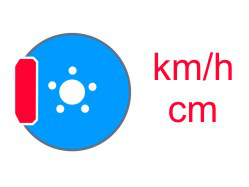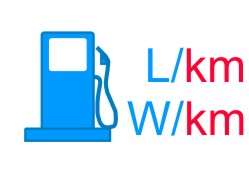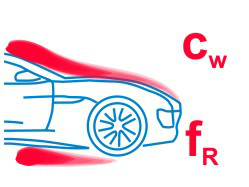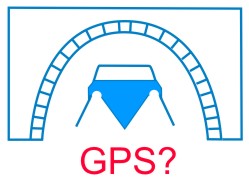LUXACT 1D Compact
|
Downloads
| ||||||
The new LUXACT® 1D COMPACT sensor is a multifunctional, powerful tool for contactless, slip-free speed over ground measurement. This sensor incorporates the proven and tested, unique LUXACT® optical technology, which is free of environment disturbances, like abrupt changing surface properties, heights to the ground variations, splashes of water, EM noise and objects crossing the field of vision. In addition, sensor’s versatile body contains a six degree of freedom inertial measurement unit (IMU) and performs onboard all calculations and compensations in real-time. Measurement results are available directly in CAN bus and can be processes by all industry standard CAN loggers and DAQ systems.
LUXACT® 1D COMPACT corresponds to requirements of modern automotive R&D engineers for a universal and robust high-precision speed over ground system. Integrated IMU increases dramatically the dynamic response and accuracy due to yaw, pitch and roll corrections of the optical signal during dynamic testing scenarios.
Unlike other systems, surface-specific recalibration or IMU setup are not required making the testing process more efficient.
LUXACT® 1D COMPACT corresponds to requirements of modern automotive R&D engineers for a universal and robust high-precision speed over ground system. Integrated IMU increases dramatically the dynamic response and accuracy due to yaw, pitch and roll corrections of the optical signal during dynamic testing scenarios.
Unlike other systems, surface-specific recalibration or IMU setup are not required making the testing process more efficient.
Brake testing

LUXACT measures not only speed and distance, but also a so called "net braking distance" in automatic mode. Just connect any of typical triggers (brake lights sensor or brake pedal) directly to LUXACT Sensor - this input is sensed with nanoseconds accuracy. Once an armed trigger is released, LUXACT starts counting the distance since trigger signal.
Before a car really stands still, it performs typically a forward & backward pitching. This natural car movement results in a typical sinusoidal speed curve at the end of a braking, which is a potential source of errors for any kind of speed sensors (Doppler & standard GPS, Microwave Radar, 5th wheel etc.). LUXACT measures speed direction and can calculate the distance in "net mode" (subtract distance while driving backward and add while driving forward).
Summing up, you can achieve easily a repeatability of brake distance <0,05% (ca. 2cm on 40m), save time on post-processing in order to eliminate forward pitching and reduce costs, as LUXACT is a self-contained integral system which solely needs to be connected to any CAN bus logging device.
Before a car really stands still, it performs typically a forward & backward pitching. This natural car movement results in a typical sinusoidal speed curve at the end of a braking, which is a potential source of errors for any kind of speed sensors (Doppler & standard GPS, Microwave Radar, 5th wheel etc.). LUXACT measures speed direction and can calculate the distance in "net mode" (subtract distance while driving backward and add while driving forward).
Summing up, you can achieve easily a repeatability of brake distance <0,05% (ca. 2cm on 40m), save time on post-processing in order to eliminate forward pitching and reduce costs, as LUXACT is a self-contained integral system which solely needs to be connected to any CAN bus logging device.
Energy consumption

In frames of a consumption measurement system, LUXACT plays a supporting role, as it does not measure the fuel flow or respectively the current. However one should not underrate the meaning of this role - the accuracy of a total consumption measurement system is as accurate as its component parts are.
We understand LUXACT as a plug and play sensor in a cunsumption measurement setup. It can be connected via a CAN bus or via flexibly programmed TTL output, directly from LUXACT Sensor.
No setup, no calibrations, no parametrization are needed.
We understand LUXACT as a plug and play sensor in a cunsumption measurement setup. It can be connected via a CAN bus or via flexibly programmed TTL output, directly from LUXACT Sensor.
No setup, no calibrations, no parametrization are needed.
Coast Down & Rolling resistance

Coast-down and rolling resistance tests are simple, but effective experimental methods to determin or validate vehicle data. These tests require especially accurate, smooth and repeatable speed measurements in order to have a low spread of velocity - deceleration values. LUXACT has an extremely low noise signal and is easy to use with any CAN bus/TTL capable data acquisition system without any additional electronics. In order to least influence cw value the sensor can be mounted horizonally under the vehicle, flush with the undercoat surface.
Inertial measurement unit support, unmanned vehicles & road profilometry

Recent successful
developments of inertial sensors, especially MEMS based IMUs with GPS support lead
to a wide usage of these systems. The biggest challenge in this application is
to reduce natural bias drifts of inertial sensors by use of GPS signal and
combining both in an automated algorithm which is usually based on a Kalman
filter. This approach proved to be a cost-effective way to create a low-drift
6DOF motion sensor by using lower priced MEMS IMUs. If GPS signal is lost or weak for any reason, which is quite realistic under
real-world conditions, such GPS-supported IMU will suffer under a dramatic
precision decrease. The scale of decrease depends on the specification of used
IMU. Manufacturer of such systems are aware
of this problem and frequently offer an input for a support signal, which is
used to enhance Kalman filtration in case of GPS signal loss.
LUXACT is suitable for this application as its accuracy and reliability are higher than this of commonly used equipment (e.g. wheel odometer). In addition it does not need to be mechanically fitted to vehicle which is in use and is not visible to the public, if mounted on the bottom of the car.
LUXACT is suitable for this application as its accuracy and reliability are higher than this of commonly used equipment (e.g. wheel odometer). In addition it does not need to be mechanically fitted to vehicle which is in use and is not visible to the public, if mounted on the bottom of the car.
